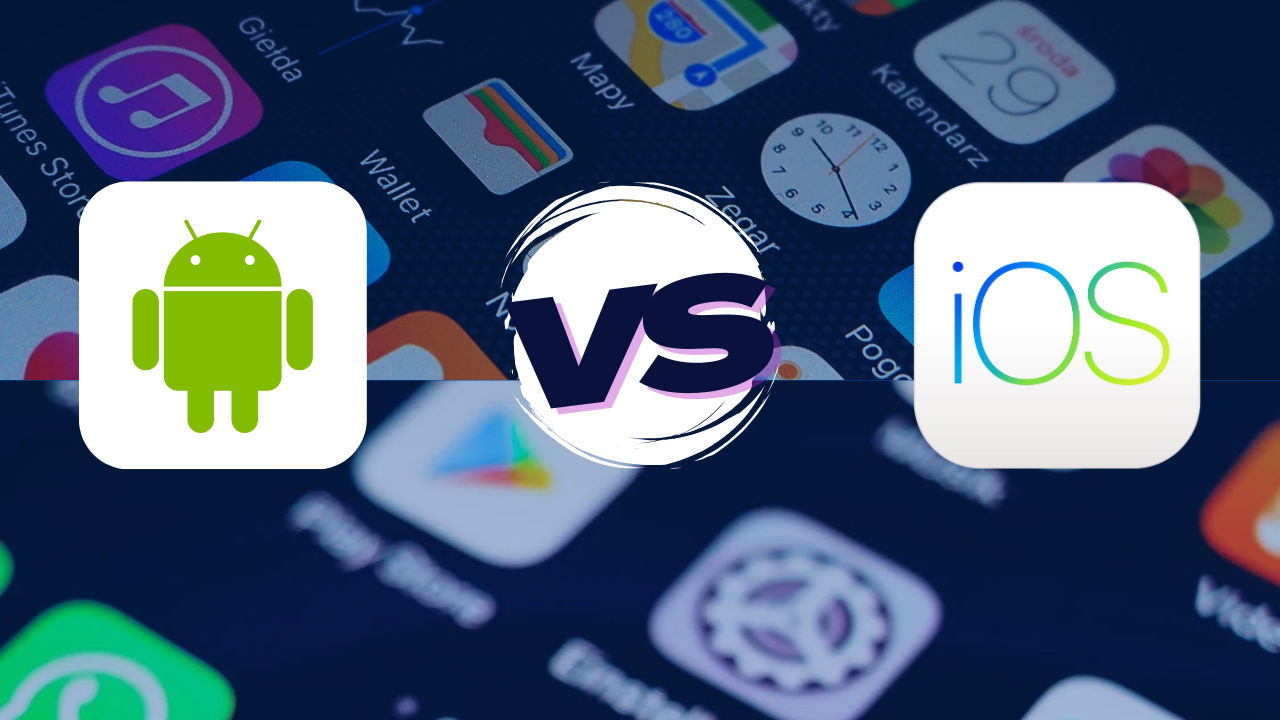When it comes to mobile app development, choosing between iOS and Android can significantly impact your app's success. Though the platforms share similar architecture, they differ in development processes, design approaches, and monetization strategies.
Android currently dominates the global operating system market with 72% market share, while iOS holds 21% and remains particularly strong in higher-income markets. This divide presents a challenge for business owners looking to maximize their return on investment.
Let's explore the key differences between iOS and Android app development to help you make an informed decision that aligns with your target audience and business goals.
What is iOS app development?
iOS app development involves creating mobile applications specifically designed for Apple devices like iPhones, iPads, and Apple watches. Developers use Apple-exclusive tools such as Xcode and programming languages like Swift and Objective-C to build high-quality apps that meet Apple's strict design and security standards.
While iOS has a smaller market share than Android, it generates about 85% more revenue, making it an attractive option for many businesses.
What is Android app development?
Android app development refers to creating applications for devices running on the Android operating system. Developers use tools like Android Studio and programming languages such as Kotlin and Java to build customizable and scalable mobile apps.
With Android dominating the global smartphone market, developing for this platform offers unparalleled opportunities to reach billions of users worldwide.
Key differences between iOS and Android app development
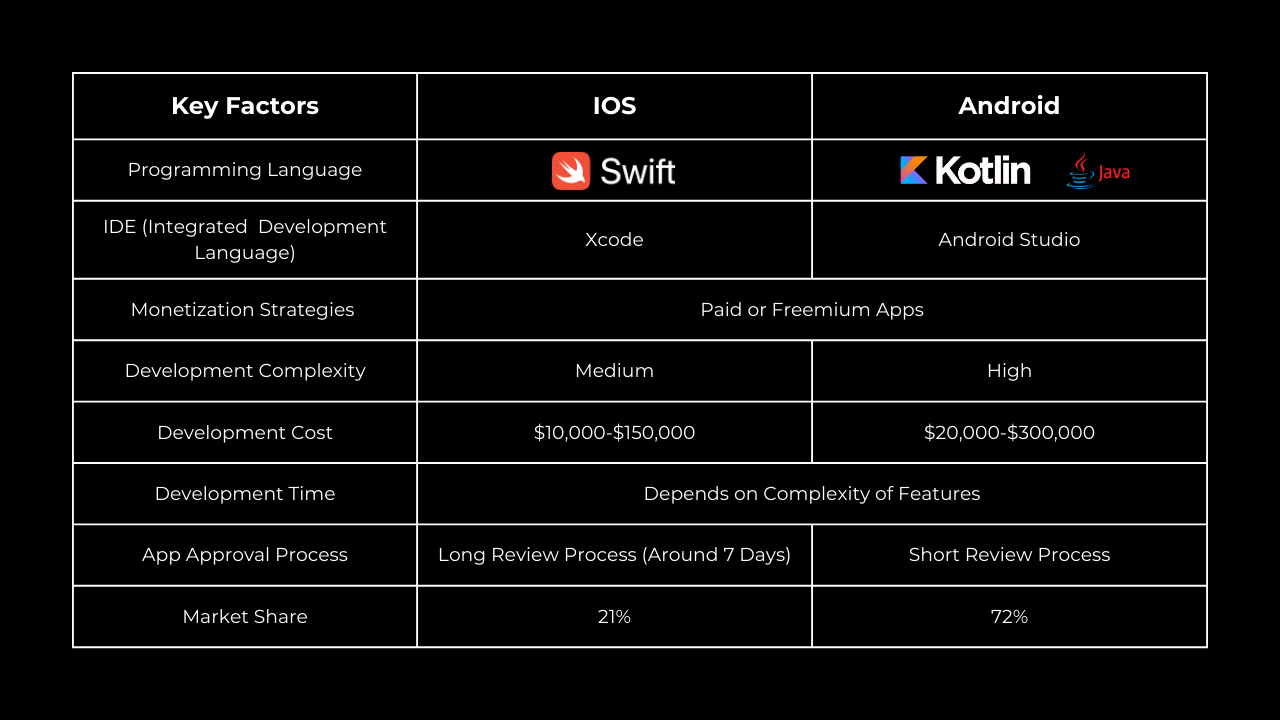
From programming languages to design concepts, security features, and development costs, both platforms have unique characteristics that affect how you approach app development.
Programming languages
iOS apps are primarily built using Swift or Objective-C. Swift is the preferred choice for many developers due to its speed, performance optimization, and safety features. It's also known for its simplicity and ease of use.
Objective-C was the original iOS programming language and remains highly stable and reliable with strong community support. However, its complicated syntax and steep learning curve can discourage beginners.
Android apps typically use Kotlin or Java. Java has long been trusted for Android development, offering strong security, stability, and robust community support.
Kotlin, developed by JetBrains in 2010, is considered an improved version of Java. Its clean, concise syntax allows developers to write more efficient code with fewer errors.
For those looking to reach both platforms, cross-platform development using frameworks like Flutter, React Native, or Unity is another option.
Development complexity
Creating Android apps can be more complex than iOS development because Android is an open-source operating system used by various device manufacturers. This means developers must ensure compatibility across different models, manufacturers, and screen sizes.
iOS development is generally simpler since developers only need to focus on Apple products, significantly reducing complexity compared to Android's diverse ecosystem.
App security
Security approaches differ significantly between the platforms due to their underlying architectures and policies.
Android's open-source nature offers greater flexibility but also presents challenges like fragmentation and higher vulnerability risks. This requires regular security updates and thorough testing. Additionally, the Google Play Store's less strict moderation means developers often need to implement third-party authorization solutions to ensure app security.
iOS is known for its strict security standards and privacy policies. Developers must follow rigorous security practices, including code obfuscation and end-to-end encryption, to protect user data. All iOS apps undergo an intensive review process to ensure they meet Apple's high security standards.
UI design differences
User interface design is crucial to an app's success, and each platform has its own approach.
iOS app design follows Apple's Human Interface Guidelines, emphasizing simplicity and minimalism with intuitive navigation, clean shapes, uniform icons, and a restrained color palette.
Android app design is more flexible and customizable, featuring animations, bold colors, tactile elements, and dynamic interfaces for a more engaging visual experience following Material Design Guidelines.
Understanding these design differences is essential to create apps that feel native to each platform and provide the best user experience.
Development costs
The cost of development is often a deciding factor when choosing a platform.
iOS applications generally require a significant upfront investment due to Apple's premium development tools and strict quality standards. Developers also need an active Apple Developer Program subscription, costing $99 annually for individuals or $299 for enterprises.
For Android apps, costs can add up due to the need for compatibility testing across many devices. The fragmented Android ecosystem requires extensive testing and optimization to ensure smooth performance across all OS versions and devices, increasing both development time and costs.
Target audience demographics
Android dominates globally, particularly in more cost-sensitive markets. Android devices are generally more affordable and accessible worldwide, especially popular in countries like India, China, Brazil, and throughout Southeast Asia.
iOS targets higher-income regions including North America, Europe, and Australia. These users typically prefer premium features, seamless experiences, and elegant design. iOS users are also more likely to make in-app purchases and subscribe to services, making the platform ideal for businesses targeting premium markets.
App testing processes
Testing approaches differ significantly between the platforms due to their ecosystem differences.
iOS offers an integrated ecosystem with limited device variety and OS versions, simplifying the testing process. Developers can focus on optimizing performance and ensuring compatibility with the latest Apple devices using tools like Xcode's built-in testing framework and TestFlight.
Android's diverse environment requires more rigorous testing across various devices, screen sizes, and OS versions. The platform's fragmentation demands strict quality control, and developers use tools like emulators, Firebase Test Lab, and Android Studio to identify and resolve potential issues.
Market share
Android holds over 71% of the global smartphone market, making it the preferred platform for businesses targeting a wide audience, especially in emerging markets.
iOS, while having a smaller global share, remains popular in developed countries with higher-income users who are more likely to spend on premium apps and services.
Development time
Development speed is another important consideration that directly impacts costs.
iOS apps typically develop faster due to Apple's streamlined tools and integrated ecosystem with fewer device variations.
Android development generally takes longer because of the wide range of devices and OS versions, requiring more time to address compatibility issues and optimize performance across various devices.
Development environments
Each platform uses different development environments with unique strengths.
Android developers use Android Studio, Google's official Integrated Development Environment (IDE) introduced in 2013. It provides comprehensive tools for debugging, code editing, testing, and performance optimization, along with Android-specific tools and APIs.
iOS developers rely on Apple's XCode IDE, which integrates seamlessly with Apple's ecosystem and offers powerful tools for testing, coding, and debugging Apple device applications.
Android app development: Pros and Cons
With over 3.3 billion users worldwide, Android has become one of the most widely used technologies, with applications serving almost every imaginable function.
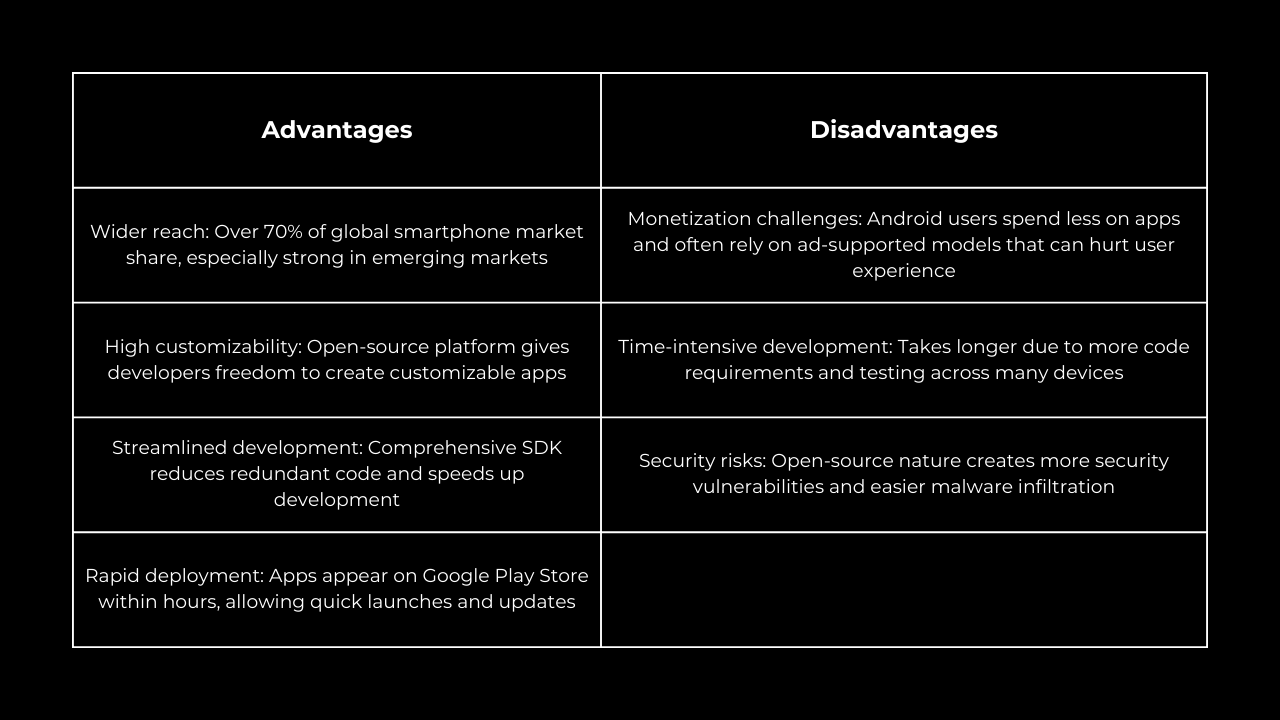
iOS app development: Pros and Cons
Known for premium products and high profitability, iOS development is ideal for businesses targeting high-income users in developed markets, though Apple's closed ecosystem presents its own challenges.
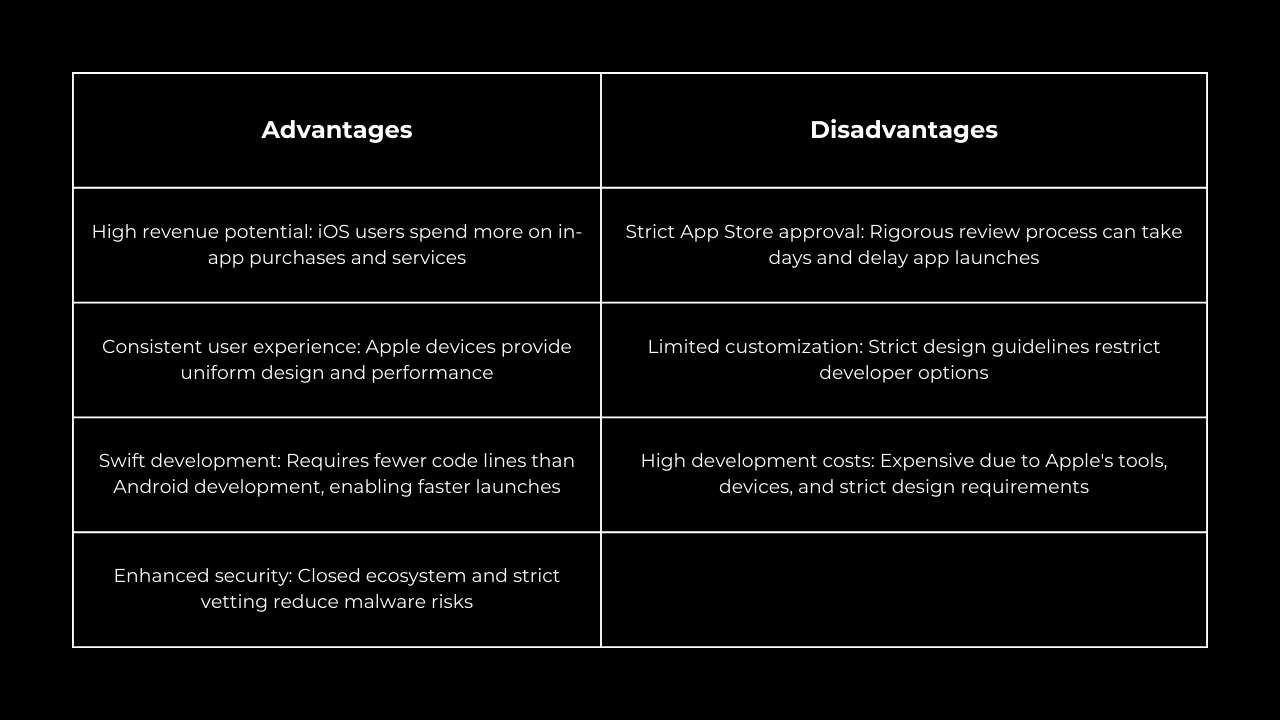
iOS vs Android: Head-to-Head Comparison
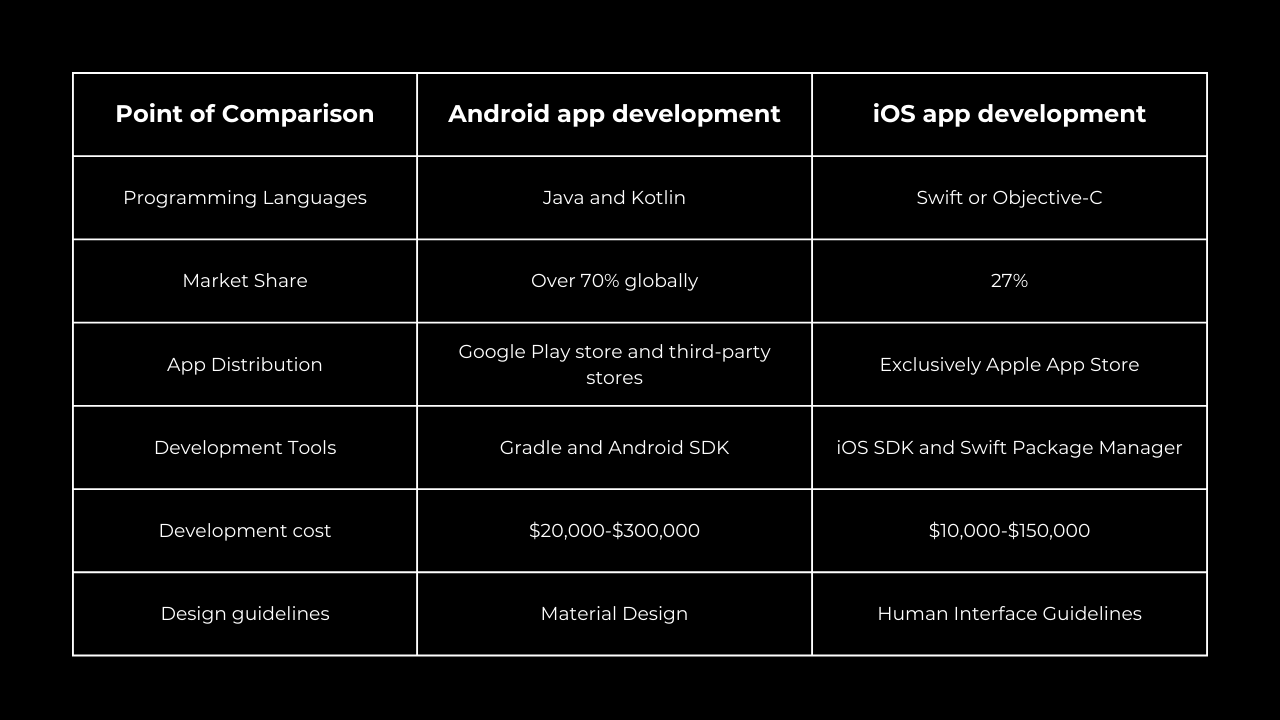
One key difference is that iOS offers a streamlined ecosystem with greater control and security, while Android's open-source nature introduces more potential security issues despite its flexibility and wider device support.
Which platform should you choose first?
Selecting the right platform depends on factors like your target audience, requirements, budget, desired features, and revenue expectations.
Android has the largest global market share, making it ideal for reaching a broad user base. iOS is popular in developed countries with higher-income users who spend more on apps.
If you want to target both platforms, a cross-platform app might work well. However, for the best performance and user experience, starting with native development on one platform is recommended. This lets you tailor your app to your target audience and build a solid foundation before expanding to the other platform.
Development costs: iOS vs Android
Cost is often a crucial factor in platform selection. App development costs vary based on feature complexity, requirements, and platform choice.
Android development can be more expensive due to the wide range of devices running Android OS. iOS development is typically faster and more cost-effective because of Apple's closed ecosystem and limited device variety.
Here's a cost breakdown based on app complexity:
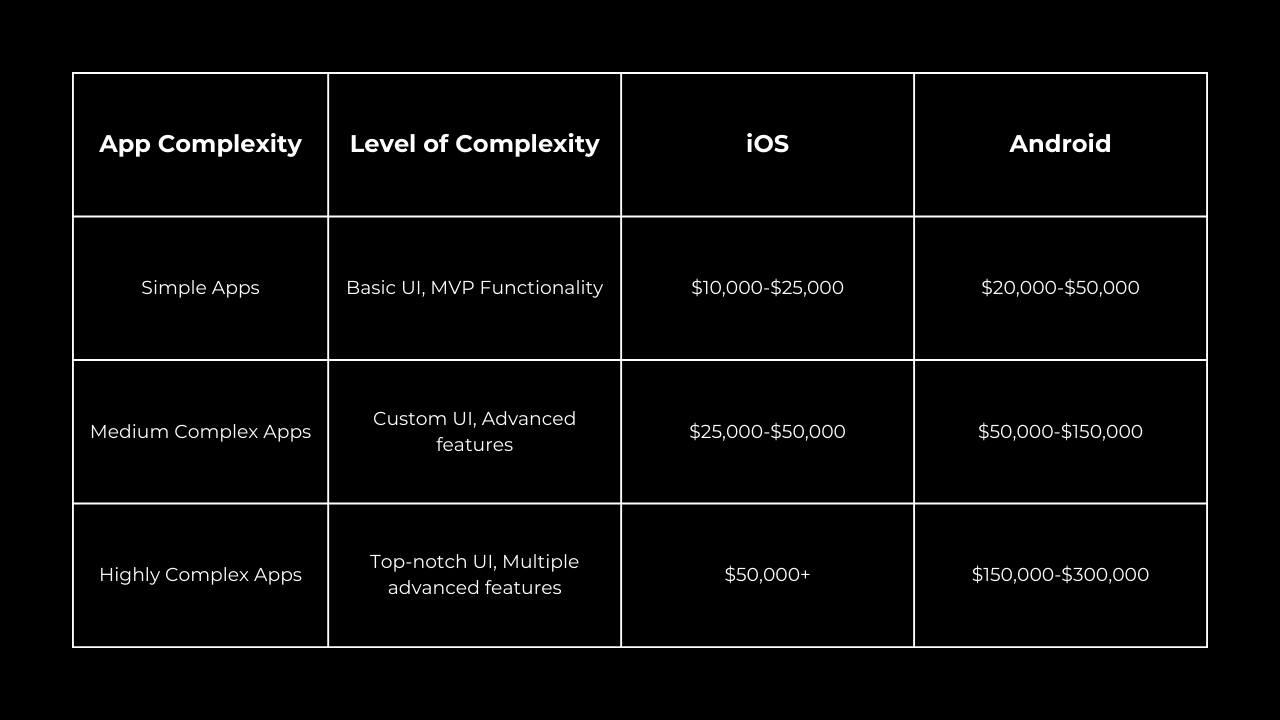
Design considerations
Design requirements differ between platforms due to specific guidelines. Android developers must follow Material Design Guidelines, while iOS developers adhere to Human Interface Guidelines.
iOS prioritizes clean, minimalist design with consistency across apps, while Android offers more flexibility and customization options. iOS designers typically use standardized UI elements like navigation bars and tab bars, whereas Android follows material design with more visually appealing and bold interfaces.
App store differences
The Apple App Store and Google Play Store differ significantly in their approaches. The App Store implements a stricter review process to ensure high quality and security. The Google Play Store reviews apps quickly and allows easier deployment.
User behavior also varies between platforms. iOS users more frequently make in-app purchases, while Android users prefer free apps. These differences impact your app's reach, revenue generation, and user acquisition.
Monetization strategies
Monetization approaches vary between platforms. iOS apps typically generate revenue through premium pricing and subscription models as iOS users are more willing to pay for apps and make in-app purchases. Android apps often rely on advertising and freemium models since users prefer free downloads.
iOS offers greater potential for higher per-user revenue, while Android provides broader audience reach but requires more intensive marketing to generate comparable revenue.
Making your decision
Choosing between iOS and Android development depends on your unique business goals, target audience, project requirements, and available resources.
Android offers wider reach and flexibility, making it perfect for businesses targeting global audiences. iOS suits companies offering premium services to high-income users in developed regions. Cross-platform development can help reach both markets to maximize potential audience and revenue.
Whether you choose Android, iOS, or both platforms, understanding each platform's strengths will help you make an informed decision that drives your app's success and growth.
